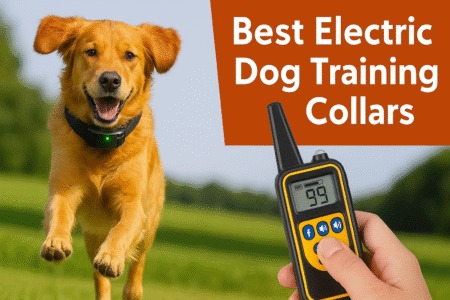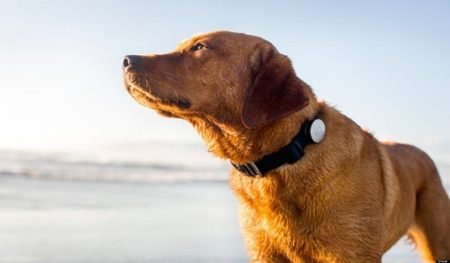Did you know thousands of dogs go missing every year in the United States? A GPS dog collar can be a lifesaver. It lets you track your pet’s location in real-time.
A GPS tracker for dogs is not just a luxury; it’s a necessity for many dog owners. With the rise of pet technology, GPS dog collars have become increasingly popular. They offer peace of mind for those who worry about their dog’s safety.
In this article, we’ll explore the benefits of using a best gps dog collar. We’ll also look at what features to look for when choosing one. By the end, you’ll know how to pick the perfect GPS dog collar for your furry friend.
What Is a GPS Dog Collar and How Does It Work?
GPS dog collars are key for pet owners who want to keep their dogs safe. They are wearable devices that track your dog’s location using Global Positioning System technology. This tech gives you real-time updates on your dog’s whereabouts, helping you keep them safe.
The Technology Behind GPS Dog Collars
GPS dog collars use GPS, cellular, and sometimes Wi-Fi or radio frequency to track your dog. The GPS technology pinpoints your dog’s location accurately. Cellular networks send this data to your phone or computer. Some collars also use Wi-Fi or radio frequencies for better tracking or to monitor your dog’s activity.
Different Types of Pet Tracking Systems
There are many pet tracking systems out there, like GPS, radio frequency (RF), and cellular-based ones. GPS-based systems are popular for their wide coverage, perfect for dogs that explore a lot. RF systems work well in smaller areas like homes or yards. Cellular-based systems use cell networks and are often cheaper but might not work well in areas with poor cell service.
Knowing about these technologies and systems helps you pick the right GPS dog collar. Whether you need something simple or advanced, there’s a collar out there for you.
Why Every Dog Owner Should Consider a GPS Collar
Many dog owners worry about their pets escaping or getting lost. A GPS collar can ease this worry. It’s a vital tool for keeping pets safe and giving them freedom.
Peace of Mind for Owners of Escape Artists
Some dogs are experts at escaping. Their owners are always on edge, fearing they’ll get lost. A GPS collar offers real-time tracking, helping find dogs quickly if they escape.
This is a big help for dogs that love to run off. It lets owners know their pets are safe and can be found fast.
Safety Benefits for Active and Outdoor Dogs
Active or outdoor dogs face many dangers, like getting lost or meeting wildlife. A GPS collar keeps an eye on them at all times. It’s a big safety boost.
For example, if a dog strays during a hike, the GPS collar helps track them down. This prevents them from facing harm.
Let’s look at some GPS dog collars to see their differences:
| GPS Collar Model | Tracking Feature | Battery Life |
| Model A | Real-time tracking | Up to 7 days |
| Model B | Interval tracking | Up to 14 days |
| Model C | Real-time tracking | Up to 5 days |
Choosing the right GPS collar is key to your dog’s safety. Look at tracking features, battery life, and durability. This ensures your dog stays safe while enjoying the outdoors.
How to Pick the Best GPS Dog Collar for Your Dog
Choosing a GPS dog collar involves several key factors. It’s a smart choice for dog owners, adding safety and peace of mind. To pick the right one, consider your dog’s needs and your surroundings.
Matching Collar Features to Your Dog’s Size and Behavior
Your dog’s size and behavior are important when picking a GPS collar. Larger dogs need sturdy, comfy collars that can handle their strength. Smaller dogs require lightweight, adjustable collars that fit their necks.
If your dog likes to wander or is very active, look for a collar with good tracking and maybe activity monitoring. Think about the collar’s weight and comfort, and any extra features that suit your dog’s behavior.
Considering Your Location and Environment
Your location and your dog’s environment are also key. If you live in a rural area or your dog goes into dense woods, choose a collar with a strong signal. For city living, a collar with cellular connectivity might be enough.
Also, think about the terrain and weather your dog faces. A waterproof, durable collar is best for dogs that love water or live in rainy areas. Knowing your environment and your dog’s habits will help you find the best GPS collar.
Essential Features to Look for in GPS Dog Collars
When looking for a GPS dog collar, it’s important to think about a few key things. These features help keep your dog safe and give you peace of mind. A good GPS dog collar does more than just track your dog’s location. It also needs to fit your dog’s needs and your surroundings.

Real-Time Tracking Capabilities
A key feature of a GPS dog collar is its real-time tracking. This lets you see where your dog is at any time. It’s important to find a collar that updates you every few seconds.
Battery Life and Charging Options
The battery life of a GPS dog collar is very important. You’ll want a battery that lasts a few days, depending on how much you use it. Some collars have rechargeable batteries or solar charging options, which are very handy.
Water Resistance and Durability
Dogs often get wet, whether it’s raining or they go for a swim. So, a GPS dog collar needs to be water-resistant. Look for a collar that’s built to last and can handle different weather conditions. This keeps the collar working well and comfortable for your dog.
Range and Coverage Area
The range and coverage area of a GPS dog collar are also key. Some collars only work within a certain range or need a specific network. Knowing how far your dog might go helps you pick the right collar for your area.
By looking at these important features real-time tracking, battery life, water resistance, and range you can find a GPS dog collar. It should fit your budget and offer the features you need to keep your dog safe.
Understanding GPS Collar Subscription Plans
When you buy a GPS dog collar, knowing about the subscription plans is key. These plans affect the cost and what the device can do.
Manufacturers offer monthly and annual plans. It’s important to understand the costs of these plans.
Monthly vs. Annual Subscription Costs
Monthly plans give you flexibility, letting you change or cancel anytime. But, they might cost more over time. Annual plans usually have discounts for a year-long commitment, saving you money. Think about your budget and how long you’ll use the collar when choosing a gps collar for your dog.
- Monthly plans: More flexible, potentially higher long-term costs.
- Annual plans: Discounted rates for long-term commitment.
What Services Are Included in Different Plans
GPS dog collar plans offer various services, from basic tracking to health monitoring and alerts. Think about what your dog needs and what you want for peace of mind. Some plans include gps dog collar reviews and support.
By looking at the services in each plan, you can pick the right GPS dog collar. This ensures you and your dog get the most from your investment.
Top GPS Dog Collar Options for Different Needs
There are many GPS dog collars available, each suited for different needs and budgets. Whether your dog loves adventures or tends to wander, there’s a collar for you.

Best Overall GPS Dog Collars
The Fi Series 3 is a top choice for its advanced features. It offers real-time tracking, escape alerts, and a stylish design. Dog owners love it for its accuracy and reliability.
Budget-Friendly Options
The Whistle 3 is great for those watching their budget. It has GPS tracking and activity monitoring without the high cost. It’s perfect for those seeking a reliable collar without spending a lot.
Best for Small Dogs
Small dogs need collars that are light and comfy. The Tractive GPS Dog Collar is ideal for them. It’s small, yet packed with features like real-time tracking and geofencing.
Best for Large and Active Dogs
The Garmin Alpha 100 is great for big and active dogs. It has long battery life, a strong build, and advanced tracking. It’s perfect for dogs that love to explore.
Choosing the right GPS dog collar depends on your dog’s needs and your budget. Whether you’re looking for features, size, or price, there’s a collar on this list for you.
GPS Collar Accuracy and Reliability Factors
For a GPS dog collar to work well, it needs to be both accurate and reliable. The collar’s accuracy depends on the tracking technology and how often it updates the dog’s location.
Understanding Location Update Frequencies
The frequency of location updates is key for tracking your dog in real-time. A higher update rate means more precise and current location info. But, it can also drain the battery faster. Some collars let you adjust this rate to save battery life without losing too much accuracy.
GPS vs. Cellular vs. Radio Frequency Tracking
Different GPS dog collars use different ways to track your dog. Knowing these methods helps you pick the right one.
| Technology | Description | Advantages |
| GPS | Uses satellite signals to determine location | High accuracy, works in remote areas |
| Cellular | Uses cellular networks to transmit location data | Real-time updates, wide coverage area |
| Radio Frequency | Uses radio waves to communicate between devices | Low cost, simple setup |
When picking a GPS dog collar, think about the tracking tech and update rate you need. A gps tracker for dogs that uses both GPS and cellular tech offers the best: precise tracking and updates in real-time.
Setting Up and Using Your GPS Dog Collar Effectively
Learning how to use your GPS dog collar is vital for your dog’s safety. It’s important to set it up right and know its features well.
Initial Setup and Configuration Tips
Start by following the instructions that come with your GPS dog collar. This includes charging it, downloading the app, and creating an account. Make sure your dog’s profile is correct, with their name, size, and health info.
Some important setup tips are:
- Adjust the collar to fit your dog right
- Customize app notifications to your liking
- Learn about the different tracking options
Take time to get to know the app. This will help you use your GPS dog collar to its fullest.
Creating Safe Zones and Geofences
GPS dog collars can set up safe zones or geofences. These are virtual fences around places like your home or a park. You get alerts when your dog goes in or out, helping you track them.
To set up a geofence:
- Open the GPS dog collar app and go to the geofencing section
- Pick the area you want to make a safe zone on the map
- Choose the boundary size and what alerts you want
- Save the geofence
By using these steps and knowing your GPS dog collar’s features, you can keep your dog safer. When picking a GPS dog collar, look at how easy it is to set up and use. Also, check the quality of its features to find the best one for you.
Common GPS Dog Collar Problems and Solutions
To get the most out of your GPS dog collar, it’s key to know how to tackle common problems. These devices aim to keep your dog safe and give you peace of mind. But, you might face issues like connection problems and battery life concerns.
Troubleshooting Connection Issues
Dealing with connection problems can be tough. But, there are steps to fix them. First, make sure your GPS dog collar is correctly paired with your device. Look at the manufacturer’s guide for pairing steps, as they differ by model.
- Restart both your GPS dog collar and your smartphone or other device.
- Check for any software updates for both the collar and your device.
- Ensure you are within range of a cellular or GPS signal.
If problems continue, check the user manual or reach out to the manufacturer’s customer support for help.
Extending Battery Life in Various Conditions
Battery life is vital for any GPS dog collar. Here are some tips to help extend it:
| Condition | Tip |
| Cold Weather | Keep the collar warm when not in use to maintain battery efficiency. |
| Frequent Use | Adjust the update frequency to balance between getting timely location updates and conserving battery. |
| Weak Signal Areas | Avoid using the collar in areas with known weak cellular or GPS signals to prevent excessive battery drain. |
By tackling these common issues, your GPS dog collar will keep working well. This ensures your dog stays safe and secure. When choosing a gps collar for your dog, think about these points to avoid problems and get the most out of it.
Conclusion:
Choosing the best GPS dog collar is key to keeping your pet safe. There are many options out there. A detailed comparison can help you pick the right one.
Think about your dog’s size, behavior, and where you live. This helps you find a GPS collar that fits your needs. Whether you want real-time tracking, long battery life, or water resistance, the right collar can help prevent losing your pet.
Investing in a reliable GPS dog collar is a smart move. It keeps your furry friend safe. By choosing wisely, you can let your dog roam free while keeping them connected and safe.
















Leave a Reply